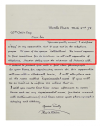ajqtrz
Chef - loquacious Old Dog
The first true computer was called ENIAC (Electronic Numerical Integrator and Computer) on the grounds of the University of Pennsylvania. Taking up 2 full floors of the building that housed it, and being made of thousands and thousands of vacuum tubes, it gave off a lot of heat and light. The heat meant it had to be kept cool, And, since, general purpose air conditioning was not in the budget (being that there was a war going on they had to make some sacrifices), they used fans to draw in cooler air from outside the building. Which would have worked fine if the building was not as old as it was and the screens on the windows often altogether missing.
So, when ENIAC first started in 1945 it blew up. Well, it popped a bunch of vacuum tubes. Investigation showed that all that, heat, light, and open air drew in the bugs, who loved the vacuum tubes. As the machine cooled at night they settled down only to be jolted awake in the morning when ENIAC was turned on. The result was every morning, the system was "debugged" with a feather duster or two. Then it was turned on. If something happened and things didn't go right they first thing they did was "debug" the system and try again. And that, is, as Paul Harvey would say, "the rest of the story."
AJ
[MOD EDIT] Corrected Title
So, when ENIAC first started in 1945 it blew up. Well, it popped a bunch of vacuum tubes. Investigation showed that all that, heat, light, and open air drew in the bugs, who loved the vacuum tubes. As the machine cooled at night they settled down only to be jolted awake in the morning when ENIAC was turned on. The result was every morning, the system was "debugged" with a feather duster or two. Then it was turned on. If something happened and things didn't go right they first thing they did was "debug" the system and try again. And that, is, as Paul Harvey would say, "the rest of the story."
AJ
[MOD EDIT] Corrected Title
Last edited by a moderator:

 Dear forum visitor,
It looks as though you have not registered for a forum account, or are not signed in. In order to participate in current discussions or create new threads, you will need to register for a forum account by clicking on the link below.
Dear forum visitor,
It looks as though you have not registered for a forum account, or are not signed in. In order to participate in current discussions or create new threads, you will need to register for a forum account by clicking on the link below.
